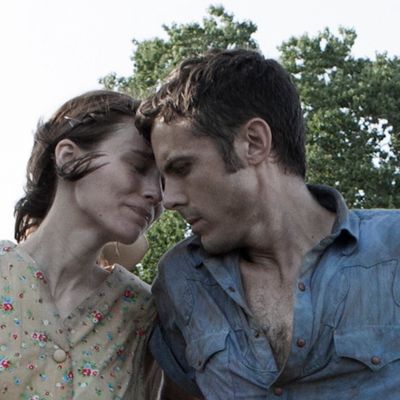
David Lowery’s Ain’t Them Bodies Saints arrives in theaters trailing clouds of Sundance glory, and at first, it’s easy to see why. It opens on a young woman, Ruth (Rooney Mara), running from a young man, Bob (Casey Affleck), then quickly making up with him after he declares that he’ll never leave her. “I don’t wanna go to jail,” she says. “You’re not going to jail,” he replies. Then she announces that she might be pregnant. The actors’ breathless, half-mumbled delivery feels like we’ve intruded on a very private moment of doubt. This is then offset by the next scene, another private moment, albeit more romantic and playful, as they sit one night in a pickup truck — right before Bob heads into an unspecified robbery with an accomplice.
The film quickly gives us snippets — flashes, really — of what happens next: We see Bob, Ruth, and their accomplice fleeing from the cops, then holing out in a shack during a shoot-out. Their partner is killed and Ruth wounds a young deputy, Patrick (Ben Foster). Bob takes the fall for shooting the man and surrenders. Everything is somehow both rushed and oblique, and you sense that, with writer-director Lowery, you’re in the presence of someone who just doesn’t like to tell stories in the usual way.
That, unfortunately, can be a good or a bad thing, and as Ain’t Them Bodies Saints moves along, its elliptical approach to drama goes from keeping us on our toes to dulling everything down. After Bob goes to jail, he dreams of the day when he and Ruth will be reunited. She raises their young daughter, keeping to herself — even as Patrick, the man she shot, begins to show some quiet, gentlemanly interest in her. Then, Bob escapes, and begins to make his way back home. Ruth, however, wants him to stay away. The issue isn’t so much that she doesn’t love him (she does), but that there can be no future in their being together.
There are so many things right with Ain’t Them Bodies Saints that it feels churlish to pick on the few things that are wrong. But unfortunately, a few miscalculations can go a long way with a story this simple and elemental. For all its heavenly cinematography — from the sun-dappled exteriors to the moody, painterly interiors — and for all the lilting, ethereal drive of its music, the film’s insistent undercutting of its narrative does its characters a disservice. There should be a cumulative power to these story lines: Bob has been waiting a long time to get back to Ruth, and Ruth has been waiting for him and fending for herself for too long. Imagine a more patient, absorbing narrative that could have given these experiences (and these talented actors) some room to breathe, allowing us to feel the weight of her decision when she effectively rejects him.
The name “Terrence Malick” has already popped up in discussions of this movie, and it’s probably fair to say that Lowery owes a debt to the director of Badlands, Days of Heaven, and The New World. Malick is one of our greatest artistic treasures, but his influence among certain indie filmmakers can be as noxious as it is rewarding. Malick’s own perverse sensibility feeds everything he does: When he chops up what seems like a perfectly good story and then presents it in a new way, he has his own distinct, and ultimately very valid, reasons. Some filmmakers have used his inspiration to powerful ends, as David Gordon Green did with George Washington and All the Real Girls. But watching Ain’t Them Bodies Saints, you wonder if maybe this movie needs a little less Malick and a little more Sidney Lumet, a little more modesty in its design and a little more focus in its narrative. There’s plenty to admire here, but it’s hard not to feel at times like we’re watching a lovely exercise in pointlessness.


